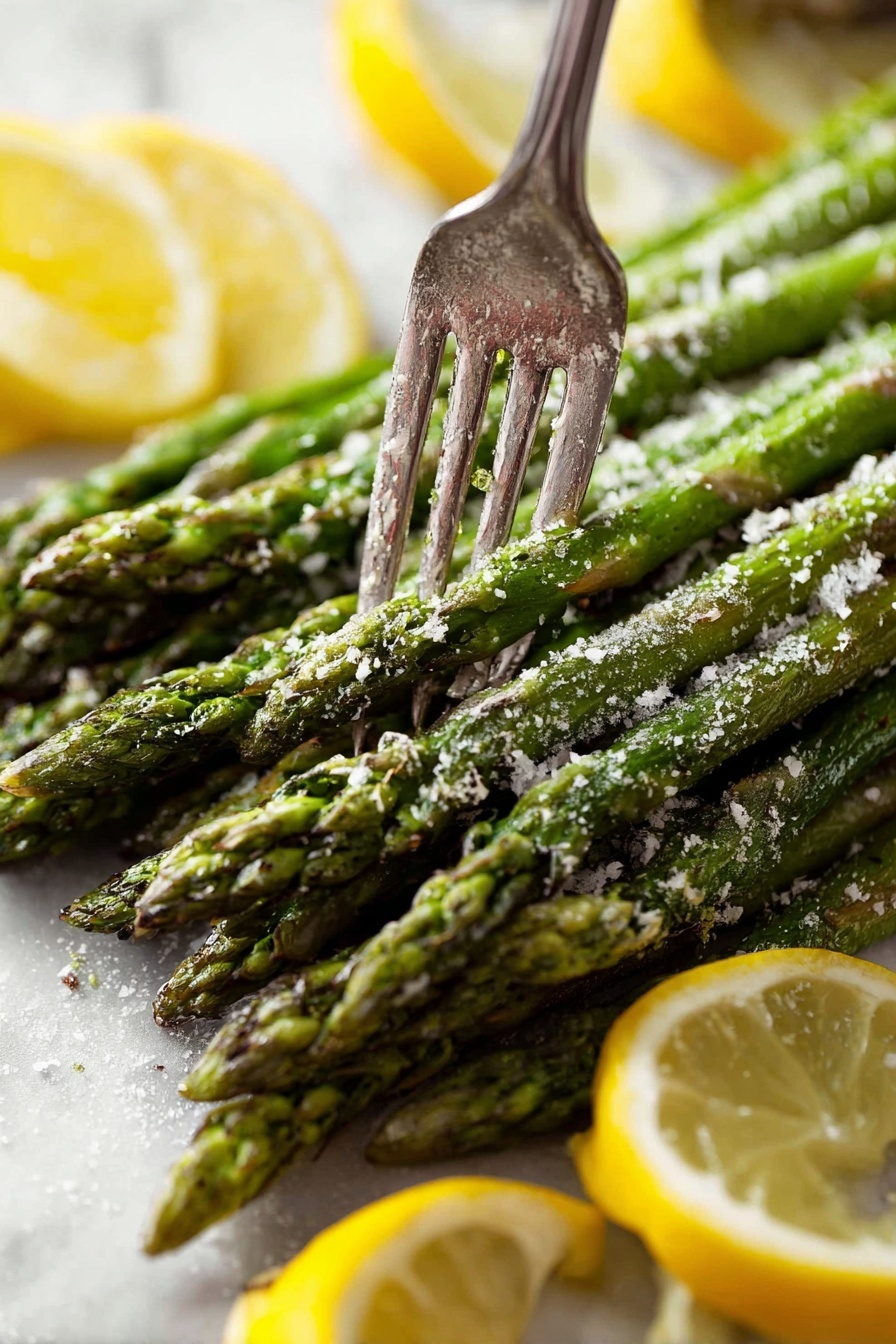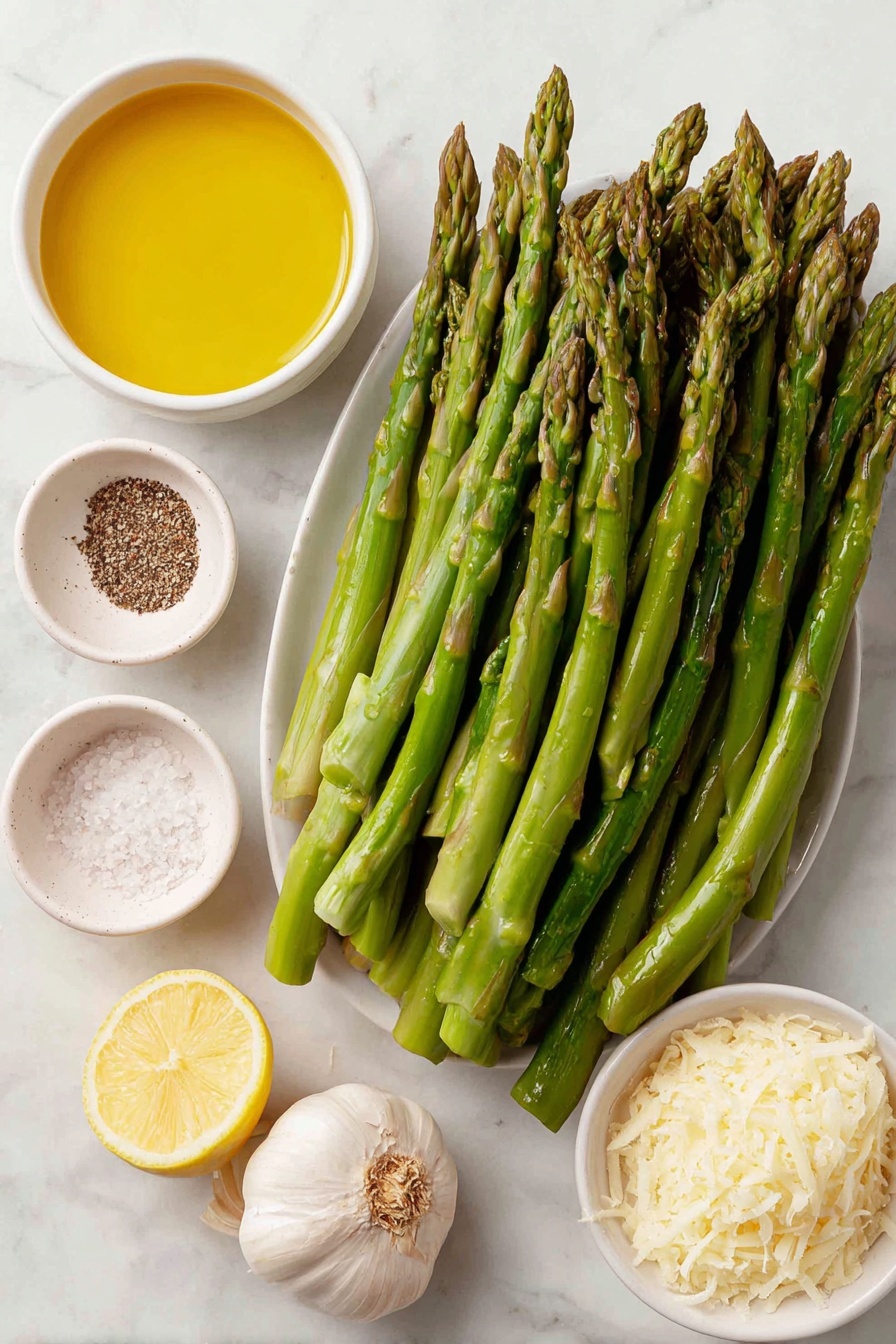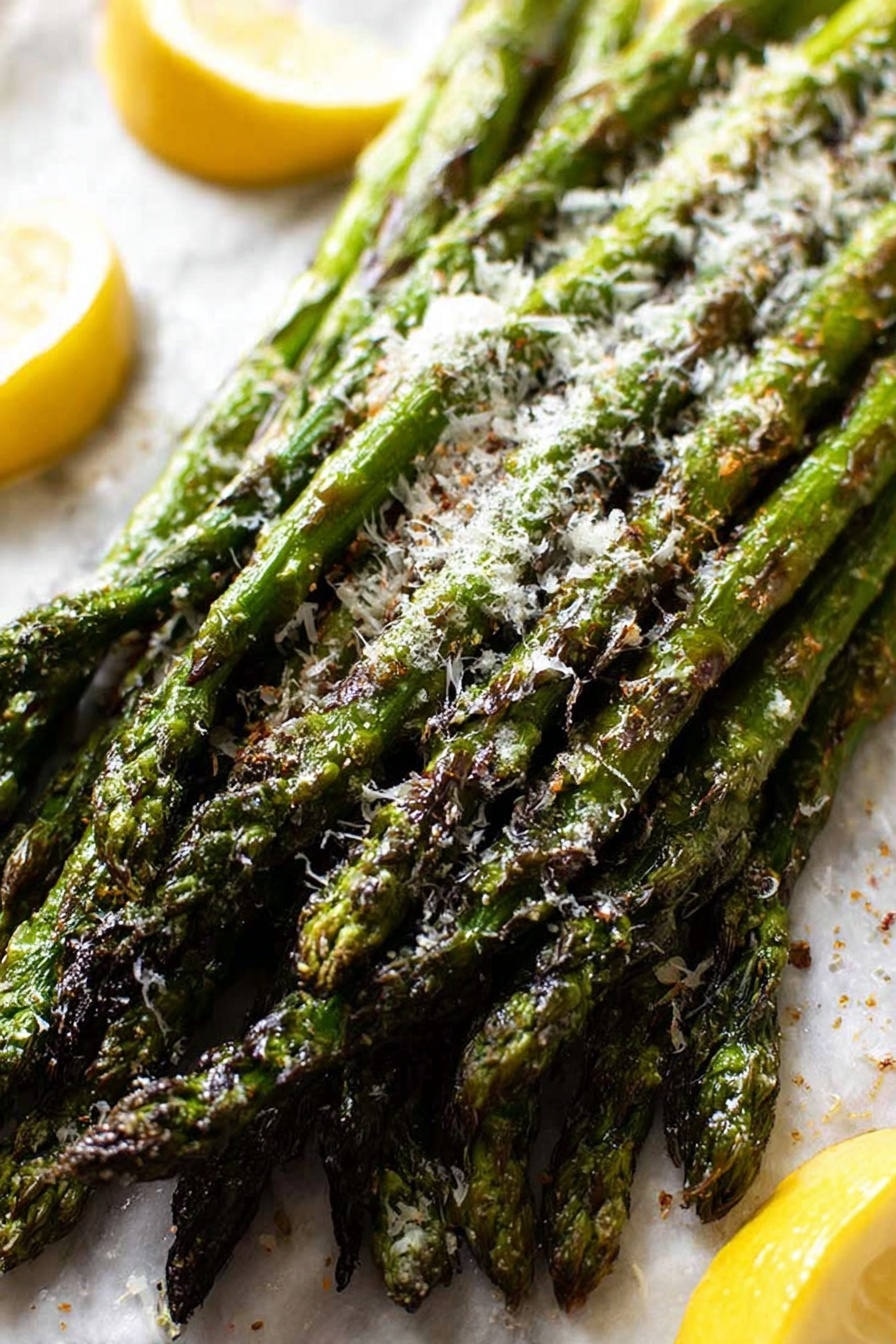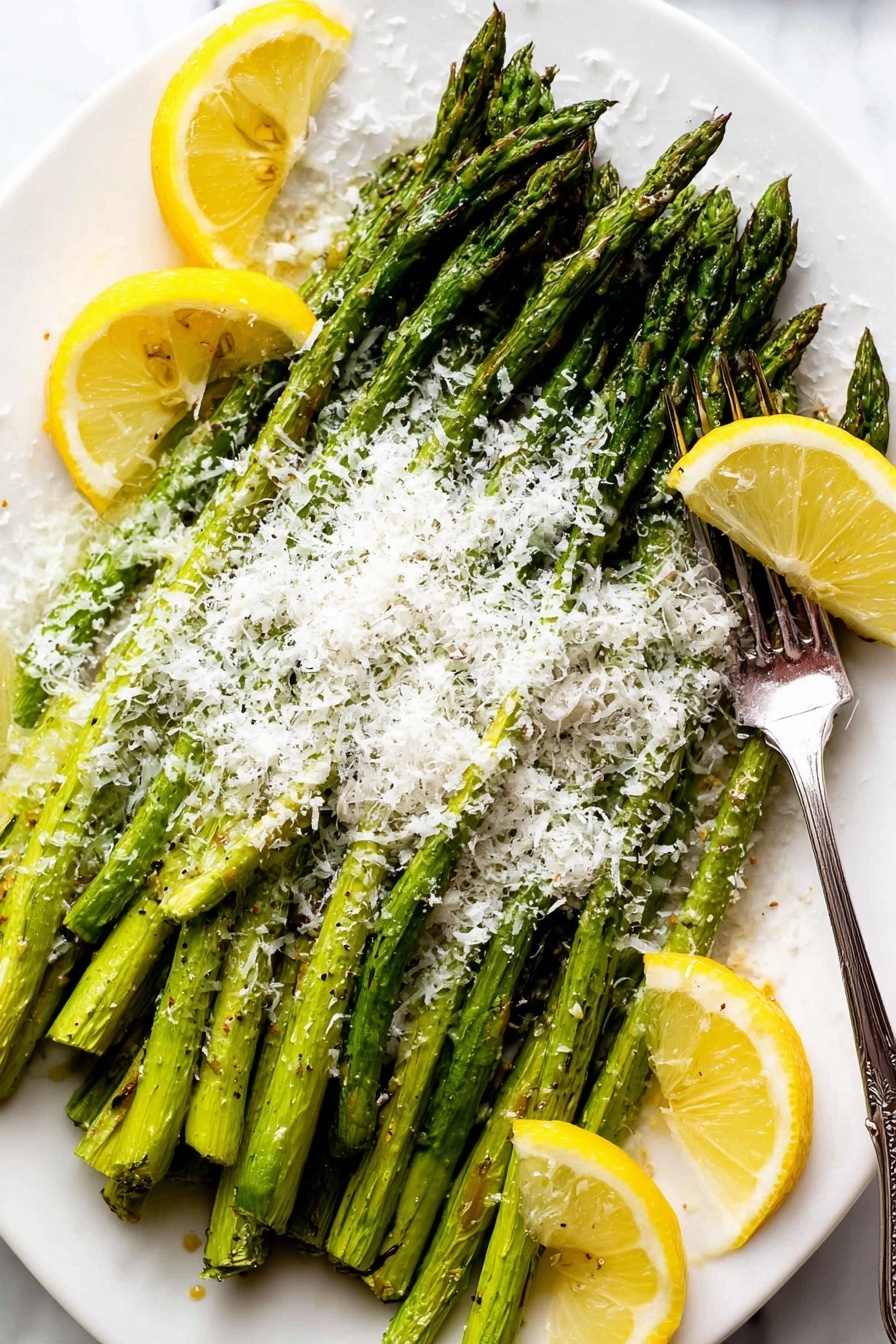There’s something incredibly satisfying about the simplicity of asparagus roasted to perfection with bright lemon and savory parmesan. This Roasted Asparagus with Lemon and Parmesan Recipe transforms humble greens into a dish bursting with flavor and texture, perfect for any meal.
Jump to:
- Why You'll Love This Recipe
- Ingredients & Why They Work
- Make It Your Way
- Step-by-Step: How I Make Roasted Asparagus with Lemon and Parmesan Recipe
- Top Tip
- How to Serve Roasted Asparagus with Lemon and Parmesan Recipe
- Make Ahead and Storage
- Frequently Asked Questions:
- Final Thoughts
- Roasted Asparagus with Lemon and Parmesan Recipe
Why You'll Love This Recipe
This recipe is my go-to when asparagus is in season, and I promise you’ll feel the same after one bite. It manages to stay crisp and fresh while packing a flavorful punch from the lemon and parmesan combo. Plus, it’s incredibly quick to whip up!
- Effortless Flavor Boost: The combination of lemon and parmesan instantly elevates basic roasted asparagus to something special.
- Quick and Easy: Takes less than 15 minutes from start to finish, making it perfect for busy weeknights or last-minute guests.
- Versatile Side Dish: Pairs wonderfully with everything from grilled meats to pastas or even brunch spreads.
- Healthy and Fresh: Brings out asparagus’s natural brightness without masking its vibrant, green goodness.

Ingredients & Why They Work
The ingredients in this Roasted Asparagus with Lemon and Parmesan Recipe are all straightforward yet thoughtfully chosen. Olive oil tenderizes and roasts the asparagus beautifully, while garlic adds subtle depth. Fresh lemon juice lends the brightness, and parmesan delivers that irresistible salty finish. When shopping, grab fresh, firm asparagus for the best texture.

- Asparagus: Look for bright green stalks with closed tips and avoid any limp or woody ends – fresher means tastier and crisper results.
- Extra virgin olive oil: Use good quality for the best flavor and smooth roasting effect.
- Salt and pepper: Simple seasonings to enhance natural asparagus flavor – don’t skip them!
- Garlic: Freshly minced works best – it imparts subtle warmth without overpowering the dish.
- Lemon juice (optional): Adds that zingy brightness that perfectly balances the rich parmesan.
- Parmesan cheese (optional): Freshly grated parmesan melts slightly over the hot asparagus, bringing creamy nuttiness.
Make It Your Way
I’ve played around with this Roasted Asparagus with Lemon and Parmesan Recipe many times, and you can easily tweak it to suit your taste or pantry. Sometimes I add a pinch of chili flakes for a little heat or swap lemon juice for a drizzle of balsamic vinegar for a touch of sweetness.
- Variation: One time, I sprinkled toasted pine nuts on top, which added a lovely crunch and nutty flavor – definitely worth a try!
- Dietary tweak: Skip the parmesan to keep it vegan; the lemon and garlic combo still makes it delicious.
Step-by-Step: How I Make Roasted Asparagus with Lemon and Parmesan Recipe
Step 1: Prep Your Asparagus Like a Pro
Start by snapping off the woody ends of your asparagus – they break naturally where the tough part ends. This little trick saves you from biting into something fibrous, and it’s way easier than measuring. Give the asparagus a good quick rinse and dry them thoroughly; wet stalks won’t roast as nicely.
Step 2: Season and Spread Out
Place your asparagus on a baking tray, drizzle generously with olive oil, then sprinkle salt, pepper, and the finely minced garlic on top. Toss everything to coat evenly – I like to do this with my hands to make sure every stalk gets love. Then spread them out in a single layer so they roast evenly and get those gorgeous browning spots.
Step 3: Roast Until Tender and Bright
Pop the tray into a preheated oven at 220°C (430°F) and roast for about 7 minutes. Keep an eye on the asparagus—the thinner the stalks, the quicker they’ll cook. You want them tender but still crisp, with a little golden color on the tips. Thicker asparagus might take closer to 10-12 minutes; just don’t let them get wrinkly or mushy.
Step 4: Finish With Lemon and Parmesan
Once out of the oven, give the asparagus a gentle toss with fresh lemon juice if you’re using it, then pile the spears onto a serving platter. Top with freshly grated parmesan—watch it melt lightly from the residual heat—and serve immediately. This final touch is what makes the dish pop.
Top Tip
After making this Roasted Asparagus with Lemon and Parmesan Recipe plenty of times, I’ve learned a few tricks that make all the difference between good and unforgettable:
- Oil it well: Don’t skimp on olive oil; it helps the asparagus roast evenly and develop a lovely, slightly crispy texture.
- Don’t overcrowd the pan: Give the asparagus room on the tray to roast rather than steam — this keeps them crisp, not soggy.
- Timing matters: Check asparagus around 7 minutes to avoid overcooking; you want a nice snap but tender bite.
- Lemon last: Add lemon juice after roasting so it stays bright and fresh, not cooked dull.
How to Serve Roasted Asparagus with Lemon and Parmesan Recipe

Garnishes
I usually keep garnishes simple—freshly grated parmesan and a sprinkle of extra lemon zest if I’m feeling fancy. Sometimes, a few toasted pine nuts add a surprising crunch. A pinch of chili flakes can also bring subtle heat if you like a little kick.
Side Dishes
This asparagus pairs exceptionally well with grilled chicken or salmon, but it’s also a delicious side for creamy risottos or roast potatoes. I love adding it to a brunch table alongside eggs and fresh bread — it’s a refreshing green element that brightens everything up.
Creative Ways to Present
For dinner parties, I’ve served this asparagus stacked in neat bundles tied with fresh herbs like rosemary or thyme. It makes for a pretty presentation and helps guests take just the perfect portion. You can also arrange spears on a long platter, drizzle some balsamic glaze, and sprinkle edible flowers for an elegant touch.
Make Ahead and Storage
Storing Leftovers
Leftover roasted asparagus can be stored in an airtight container in the fridge for up to 2 days. I find the texture remains surprisingly good, just avoid reheating too long to keep the snap.
Freezing
I wouldn’t recommend freezing roasted asparagus as it tends to get mushy when thawed—fresh is best to enjoy the crisp texture and vibrant flavors.
Reheating
To reheat leftovers, I pop them in a hot skillet or under the broiler for just a minute or two to warm through and crisp back up. Using the microwave tends to make them soft and less enjoyable.
Frequently Asked Questions:
Frozen asparagus doesn’t work as well for roasting because it tends to release moisture and become soggy rather than crisp. Fresh asparagus is best to ensure a tender yet firm texture after roasting.
You want the asparagus to be tender but still have a slight snap when you bite into it. Look for slight browning on the tips and joints, which adds extra flavor without letting the stalks get mushy or wrinkly.
Absolutely! Simply skip the parmesan cheese or use a vegan cheese alternative. The lemon and garlic bring plenty of flavor on their own.
The best way is to use a hot skillet or broiler for a minute or two to warm the asparagus without it becoming soggy. Microwaving tends to make it soft, so I usually avoid that method.
Final Thoughts
This Roasted Asparagus with Lemon and Parmesan Recipe is truly one of those simple dishes that never fails to impress me—and the best part is, it’s so easy to make. Whether you’re a weeknight warrior or entertaining friends, this asparagus is guaranteed to bring fresh flavor and a bit of wow factor to your table. Give it a try and let me know if it becomes one of your favorites too!
Print
Roasted Asparagus with Lemon and Parmesan Recipe
- Prep Time: 5 minutes
- Cook Time: 12 minutes
- Total Time: 17 minutes
- Yield: 4 servings
- Category: Side Dish
- Method: Baking
- Cuisine: Australian
- Diet: Low Fat
Description
This Roasted Asparagus recipe offers a simple, flavorful side dish featuring tender asparagus spears tossed with olive oil, garlic, salt, and pepper, then roasted until lightly caramelized. Optional finishes include a bright splash of lemon juice and freshly grated parmesan to elevate the flavor.
Ingredients
Main Ingredients
- 500 g asparagus (about 1 lb or 3 standard Australian bunches)
- 1 ½ tablespoon extra virgin olive oil
- ¼ teaspoon salt
- ¼ teaspoon black pepper
- 1 garlic clove, finely minced
Optional Finishes
- 2 tablespoon lemon juice
- 2 tablespoon parmesan, freshly grated
Instructions
- Preheat the oven: Set your oven to 220°C (430°F) or 200°C fan assisted to get it ready for roasting.
- Prepare the asparagus: Snap the woody ends off the asparagus; they will naturally break at the right point, ensuring you discard the tough parts.
- Toss with seasonings: Place the asparagus on a baking tray, drizzle with extra virgin olive oil, sprinkle with salt, pepper, and the finely minced garlic. Toss well to coat evenly, then spread out the spears in a single layer.
- Roast the asparagus: Place the tray in the oven and roast for 7 minutes or until the ends have light color and the asparagus is just tender. For very thick spears, roast for 10 to 12 minutes. Avoid overcooking to keep the asparagus from becoming wrinkly.
- Finish and serve: Remove the asparagus from the oven. If desired, toss with lemon juice for brightness, then pile onto a serving platter and grate fresh parmesan over the top before serving.
Notes
- Choose asparagus spears that are firm and bright green for the best flavor and texture.
- If you prefer a milder garlic flavor, you can roast the clove whole alongside the asparagus.
- Adjust cooking time based on thickness of asparagus: very thick spears need longer roasting.
- For a dairy-free version, omit parmesan and use lemon juice only.
- Serve immediately for the best flavor and texture, as roasted asparagus can lose its crispness when cooled.
Nutrition
- Serving Size: 125 g
- Calories: 70 kcal
- Sugar: 2 g
- Sodium: 150 mg
- Fat: 5 g
- Saturated Fat: 0.7 g
- Unsaturated Fat: 3.5 g
- Trans Fat: 0 g
- Carbohydrates: 6 g
- Fiber: 3 g
- Protein: 3 g
- Cholesterol: 0 mg







Leave a Reply